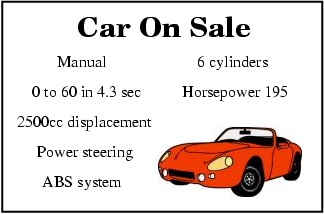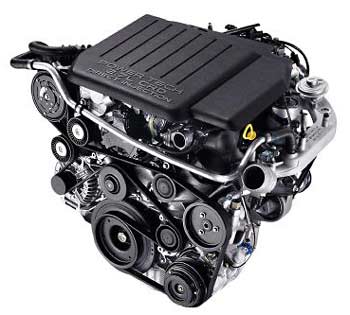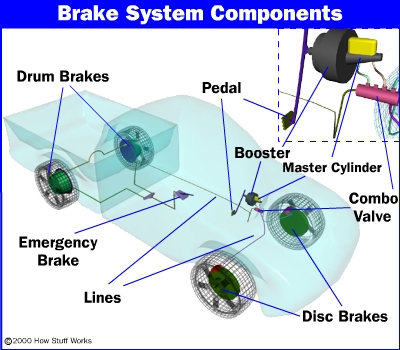- Force of friction
When the brake is pressed, a huge stopping force would be generated. Obviously,
this force would stop the rotation of the wheels in order to stop the motion of
the vehicle. How can this be done? In fact, the stopping force slows down the spin
of the wheels by generating friction on it. To
understand the working mechanism of the braking system, let us begin by taking a
quick look on friction.
When one surface slides over another surface, the so-called frictional force that
resists the sliding motion would appears. Friction is a measure of how hard it is
to slide one object over another (i.e. for the sliding between the surface of the
two objects). It was found that the friction depends on the roughness of the
contacting surfaces. Indeed, friction would exists even the surfaces are very
smooth.
|
Why friction appears?
|
The friction is due to the irregularities on a surface. If we look at
any surface through the microscope, you will see many small peaks and
valleys (the irregularities). If two surfaces rub over each other, the
irregularities on the two surfaces would get squished together resulting
in a frictional force that opposes the motion. We should note that
frictional force exists even the surfaces in contact are not in relative
motion. For example, if you push a heavy block slightly, the block might
not move. It is because you have not applied a large enough force to
overcome the frictional force between the block and the floor under the
block.
|
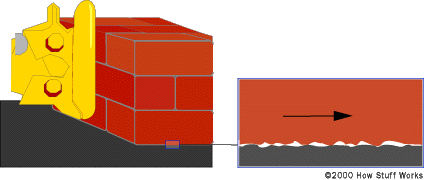
|
|
Friction at microscopic scale [viii]
|
|
Suppose you want to push two different weight blocks to another location
by the bulldozer as shown in the figure below. If the two blocks are made
of the same material, which one will be harder to push? In fact, the
heavier one will be harder for the bulldozer to push. Why? It is because
the weight of the heavier block causes the irregularities on the
contacting surfaces to squish together much more and thus gives rise to a
larger frictional force for the heavier block. It implies that the amount
of force required to move a block is proportional to that block's weight;
larger force is need for heavier weight. This principle has been applied
for many devices such as brakes and clutches, where a pad is pressed
against a spinning disc. More force pressing on the pad would result in
greater stopping force.
|

|
|
Which block has a larger friction? [viii]
|
|
In addition, the friction resisting the slide of a block would also
depends on the material made up the block since different materials have
different microscopic structures. For example, sliding rubber against
rubber is harder than sliding steel against steel.
|
The friction force of sliding a block over a surface is measured by the
coefficient of friction that is the ratio of the force required to slide the
block to the block's weight. The coefficient of friction is a dimensionless unit and
has a value greater than or equal zero. A smaller value means a more slippery surface.
For a perfectly smooth surface, the coefficient of friction is zero. To be concrete,
let us consider an example. Suppose the coefficient of friction for
sliding blocks made of certain material over a surface is 1.0, then it would take
100 pounds of force to slide the 100-pound block, or 300 pounds of force to slide
the 300-pound block. If the coefficient of friction is 0.1 rather than 1.0, then
it will take 10 pounds of force to slide to the 100-pound block or 30 pounds of
force to slide the 300-pound block.
We should be aware that the coefficient of friction would be different if the
surfaces of contact are relatively in motion instead of at rest. The coefficient
of static friction refers to the case that the two surfaces in contact are not
sliding relative to each other. Moreover, the coefficient of dynamic friction
corresponds to the case that the two surfaces are sliding relative to each other.
The coefficient of dynamic friction is usually less than the coefficient of static
friction, which implies more force is required to move a static object than to keep
it moving. The following table lists the coefficients of friction for a few
instances.
The coefficients of friction for several cases [iii]
|
Coefficient of
static friction |
Coefficient of
dynamic friction |
| Rubber on concrete |
0.90 |
0.70 |
| Copper on glass |
0.68 |
0.53 |
| Oak wood on oak wood |
0.54 |
0.32 |
| Steel on ice |
0.02 |
0.01 |
The table below shows that the coefficient of friction of the tires of a vehicle
moving on a concrete road varies a large amount under different circumstances.
The coefficients of friction of the vehicle's tires under different
circumstances [iii]
|
Coefficient of
static friction |
Coefficient of
dynamic friction |
| Dry concrete at low speed |
0.9 |
0.7 |
| Dry concrete at high speed |
0.6 |
0.4 |
| Wet concrete at low speed |
0.7 |
0.5 |
Besides, the coefficient of friction is also related with the stopping distance
that is the shortest distance for a vehicle to stop without skidding. In
particular, it was found that the stopping distance is inversely proportional to
the coefficient of static friction for the tires to slide over the road. As
mentioned before, the coefficient of static friction of the tires changes a lot
if the tires becomes worn out or the road condition changes due to the weather (see
below table). Therefore, the stopping distance of the vehicle varies a large
amount under different circumstances, as shown in the below table. For example,
the stopping distance of a vehicle with new tires moving at 60 mph increases
eighteen times if the vehicle moves from a dry road to an icy road. In brief,
both the road condition and condition of the tires are crucial factors determine
whether a vehicle can be easily stopped on a road.
The coefficients of static friction under various conditions for new and worn
tires [iii]
Condition
of tires |
Weather |
| Dry |
Wet
(light rain) |
Heavy rain
(puddles) |
Ice |
| At 60 mph |
| New |
0.9 |
0.60 |
0.3 |
0.050 |
| Worn |
0.9 |
0.20 |
0.1 |
0.005 |
| At 80 mph |
| New |
0.8 |
0.55 |
0.2 |
0.005 |
| Worn |
0.8 |
0.20 |
0.1 |
0.001 |
The stopping distance of a vehicle moving at 60 mph under different conditions
| Condition |
Stopping distance (feet) |
| Dry (new tires) |
134.4 |
| Light rain (new tires) |
201.6 |
| Light rain (worn tires) |
605 |
Heavy rain
(puddles and worn tires) |
1210 |
| Ice (new tires) |
2420 |
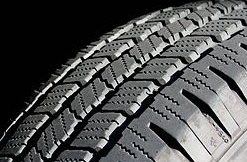
| | The tire pattern (Courtesy: The Wikipedia)
|
- The tread of a tire
In order to increase the traction or the skid resistance between the tires and the road surface, the tread pattern is
introduced to the tire surface.
Under dry conditions on paved roads, a smooth tire gives better traction than a grooved or patterned tread
because a larger area of contact is available to develop the frictional forces. For this reason, the tires
used for auto racing on the tracks have a smooth surface
with no tread design. Unfortunately, a smooth tire develops very little traction under wet conditions because
the frictional mechanism is reduced by a lubricating film of water between the tire and the road. A patterned tire
provides grooves or channels into which the water can squeeze as the tire rolls along the road, thus again providing
a region of direct contact between tire and road. A patterned tire gives typical dry and wet frictional coefficients
of about 0.7 and 0.4, respectively. These values represent a compromise between the extreme values of about 0.9 (dry)
and 0.1 (wet) obtained with a smooth tire. In a rainy day, when there is too much water on the road cars will hydroplane
if they are going too fast. Hence, the water gets between the tires and the road leaving
an unexistent frictional force. The tires are not in contact with the road so the frictional force is gone causing the car to
slid until the tires make contact with something that will cause there to be a frictional force.
Classical friction theory in the high school does not work well to the case of rolling wheels.
The reason is that the tires have structural flexibility
and tread rubber stretches when they are rolling on the road.
Instead of depending solely on the coefficient of friction at the tire-road interface
(which is determined by the nature of the road surface and the tread rubber compound), maximum stopping ability also depends
on the resistance of the tread to tearing under the forces that occur during braking. When a car is braked to a hard stop on
a dry road, the maximum frictional force developed can be greater than one's initial thought.
The result is that instead of the tire merely sliding along the road, rubber is torn off the tread at the tire-road interface.
Undoubtedly the tread resistance to this tearing is a combination of the rubber strength and the grooves and slots that make up
the tread design. The heat energy generated due to tearing of rubber reduces the speed of the car.
Some very high performance cars have both directional and asymmetric tires, but they have to be fitted the right way around on the wheels
and on the correct side of the vehicle. Also, the performance of the tires varies and it depends on the rubber compounds.
Generally, the softer the compound the better the grip on the road, but as a result they usually wear a lot quicker than harder compound
tires.
- Basic principle of the brake system
When the brake pedal is pushed, the car transmits the force from driver's foot to
its brakes through some fluid. Obviously, actual brakes require a much greater
force than that exerted by driver's leg. Thus the car must magnify the force of
driver's foot. In the brake system, the multiplication of force is attained by
making use of the two principles:
| 1. |
Leverage
|
| 2. |
Hydraulic force multiplication
|
Let us study these two principles one by one.
- Leverage
Before any force is transmitted to the brake fluid, the pedal multiplies the
force from driver's leg several times by using a lever. The force multiplication
gained by the use of lever is called the leverage.
The lever is based on the principle of lever stating that:
"The force pushing upward at one end of a lever is equal to the force
pushing downward at the other end times the ratio of the distance of the two
forces from the pivot point.
The below figure illustrates the principle of the lever.
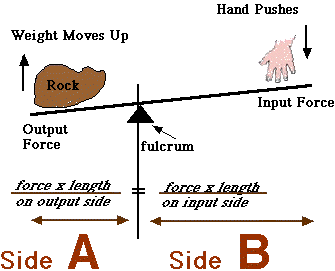 The principle of lever [xii]
The principle of lever [xii]
So we can get a bigger force at one end of a lever by applying a force at a
suitable position on the other end. Let us consider an example to explain how to
do this. In the figure below, suppose a force F is being applied to the left end
of the lever which is twice as long (2X) as the right end (X). Then a force of 2F
would be available on the right end of the lever. Besides, the force at the right
end should act through half of the distance (Y) that the left end moves (2Y). If
we change the relative lengths of the left and right ends, the force
multiplication by the lever (i.e. the ratio of the two forces) changes.
 Force multiplication by a simple leverage [viii]
Force multiplication by a simple leverage [viii]
- Hydraulic force multiplication
After multiplied by the lever, the force acted on the pedals would be magnified
by a hydraulic system consisting of some cylinders with brake fluid inside. In
fact, the workings of any hydraulic system is based on the so-called Pascal's
principle:
The pressure exerted on a confined incompressible fluid is transmitted
undiminished in all directions and acts with equal force on all equal areas (i.e.
pressure is constant).
where the pressure is the force divided by the area.
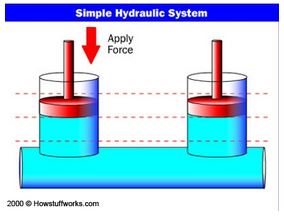 A simple hydraulic system [viii]
A simple hydraulic system [viii]
How does a hydraulic system work in practice? Let us consider a simple hydraulic
system. In the above figure, two pistons are fit into two oil-filled cylinders
which are connected together with an oil-filled pipe. If a downward
force is pushed on one piston (the left one, in this drawing), then the force is
transmitted to the second piston through the oil in the pipe. Since oil is
incompressible, almost all the applied force arrives at the second piston. (Of
course, there would be some loss due to friction or other reasons.) The advantage
for using the hydraulic systems is that the pipe connecting the two cylinders can
be any length and shape. So the connecting pipe can be a fine irregular shape
pipe so that it can snake through all sorts of things separating the two pistons.
The pipe can also have more than one openings at each end and thus one master
cylinder (the cylinder where the force is applied) can drive more than one slave
cylinder (the cylinder where the force is transmitted to) just like that in the
below figure.
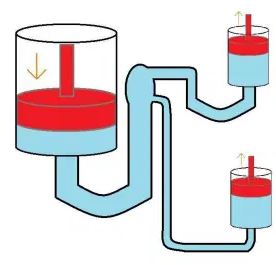 Master cylinder with two slaves [viii]
Master cylinder with two slaves [viii]
Another advantage for using a hydraulic system is that the force multiplication
(or division) can be performed easily. According to the Pascal's principle, the
pressure applied at one end of a hydraulic system would be transmitted with
constant value throughout the system. Therefore, to change the force on a
piston in a hydraulic system, all we have to do is change the size of one piston,
as shown below.
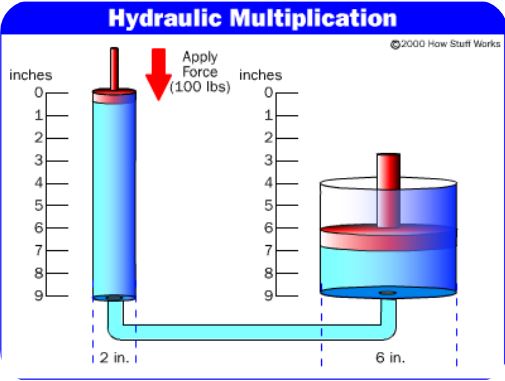 Force multiplication by a hydraulic system [viii]
Force multiplication by a hydraulic system [viii]
We can determine the factor of the force multiplication in the above system by
looking at the size of the pistons. Suppose the radius of the piston on the left
is 1 inches while the radius of the piston on the right is 3 inches. For a piston
(which is in circle shape), the area is equal to Pi*radius*radius. So the right
piston must be nine times larger than the left piston as the radius of the right
piston is three times larger than that of the left piston. Hence, any force
applied to the left-hand piston will increase nine times as it come out on the
right-hand piston. That is to say, if a 100-pounds downward force is applied at the
left piston, a 900-pound upward force will arise on the right. However, the right
piston will only raise 1 inch if the left piston is depressed by 9 inches since
the volume of the fluid displaced by the two pistons must be the same.
- A simple braking system
After learning the basic principle of the brake system, let us look at a simple
brake system as shown below.
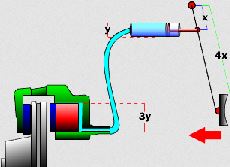 A simple brake system [viii]
A simple brake system [viii]
In this system, the distance from the pedal to the pivot is four times larger
than that from the cylinder to the pivot, so the force applied at the pedal will
be increased by a factor of four before it is transmitted to the cylinder. Then
the hydraulic system magnified the force by nine times since the ratio of the
radius of the brake cylinder to that of the pedal cylinder is three. Thus this
system all together increases the force of the driver's leg by a factor of 36.
For example, if a 10-pound force is pushed on the pedal, a 360-pound force will
be generated to squeeze the brake pads at the wheel.
There are a number of possible problems for this simple system. For instance, what
will happens if there is a leak in the system? If there is only a slow leak,
eventually the brake cylinder will not have enough fluid for the brakes to work.
In contrast, if there is a major leak, then all the fluid will rush out the leak
at the first time the brakes is stepped; and the result is a complete brake
failure. To avoid accident due to brake failure, the master cylinder in modern
cars is designed to handle these potential problems.
- Antilock braking system (ABS)
The antilock braking system (ABS) is designed to avoid the car went out of
control when the brakes lock up. Thus the system can help the driver to stop
his/her car safely even on a very slippery surface. Obviously, a skidding wheel has less traction
than a non-skidding wheel. By keeping the wheels from
skidding while the driver slow down, anti-lock brakes benefit him in two ways:
He'll stop faster, and he'll be able to steer while he stops.
The ABS system has been used
on cars since the late 1960s. Nowadays, almost all new cars are equipped with this
system.
However, the ABS does not always give rise to a shorter stop for any surfaces.
For example, it takes almost the same time for a car to stop on a dry concrete
road either by the regular brake system or ABS. However, the ABS would allow the
car to stop faster on a wet or icy road. The main function of the ABS is to avoid
the driver losing control of the car.
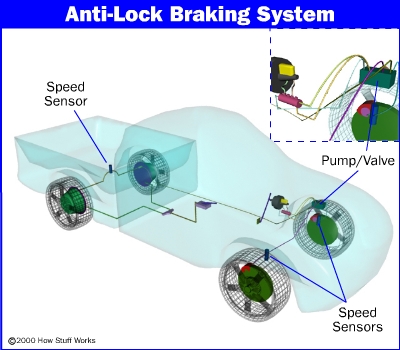 The components of the antilock brake system (ABS) [viii]
The components of the antilock brake system (ABS) [viii]
ABS works by monitoring the speed of all the wheels of the car all the time.
Based on the data received from the speed sensors mounted on each wheel, the ABS
controller looks for any abnormal decelerations in the wheel. It is because a
wheel experiences a rapid deceleration just before it locks up. It
might take five seconds for a 60 mph car to stop under ideal conditions; however,
a wheel that locks up could stop rotation in less than one second. In other words, if the
deceleration were not intervened, the wheel would stop at an abnormally fast rate.
Knowing that the ABS does not bear such a rapid deceleration, the ABS controller reduces
the hydraulic pressure to that brake until the wheel accelerates again. Then it
restores the hydraulic pressure until the abnormal deceleration appears again. It
can do this so fast that there is no significant change in the speed of the tire.
Due to the functioning of the ABS, the tire would slow down at the same rate as
the car with the brakes keeping the tires to undergo maximum deceleration for no
skidding. It results in maximum braking power for the system.
Due to the rapid stopping and starting of the hydraulic pressure by the ABS, the
person stepping the brakes will feel a pulsing of the brake pedal when the ABS
operates. Such pulsing can occur to 15 times per second for some ABS systems.
The ABS system is a valuable component of modern cars that improves the safety
of driving. However, the ABS cannot avoid all skids. For example, the ABS cannot
prevent those skids caused by excess speed, sharp turning and slamming on the
brakes. In fact, many skidding occurs before the ABS is activated. However, ABS
significantly reduces the stopping distance and helps you to keep control of your
car.
|
